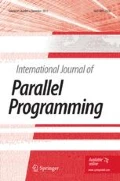Abstract
This paper describes a parsing algorithm for Tree Adjoining Grammar (TAG) and its parallel implementation on the Connection Machine. TAG is a formalism for natural language that employs trees as the basic grammar structures. Parsing involves the application of two operations, called adjunction and substitution, to produce derived tree structures. Sequential parsing algorithms for TAGs run in time quadratic in the grammar size, which is impractical for the very large grammars currently being developed for natural language. This paper presents two parallel algorithms, one running in time nearly linear in the grammar size, and the other running in time logarithmic in the grammar size. Both parallel algorithms were implemented on a Connection Machine CM-2 and performance measurements were obtained for varying grammar sizes.
Similar content being viewed by others
References
A. K. Joshi, L. S. Levy, and M. Takahashi, Tree Adjunct Grammars,J. of Comp. and Syst. Sci. 10:136–163 (1975).
A. S. Kroch and A. K. Joshi, The Linguistic Relevance of Tree Adjoining Grammars, Technical Report MS-CIS-85-16, Department of Computer and Information Science, University of Pennsylvania (April 1985).
A. K. Joshi, How Much Context-Sensitivity is Necessary for Characterizing Structural Descriptions—Tree Adjoining Grammars, Natural Language Processing—Theoretical, Computational and Psychological Perspectives, (eds.), D. Dowty, L. Karttunen and A. Zwicky, Cambridge University Press, New York (1985).
A. Abeillé, Parsing French with Tree Adjoining Grammar: Some Linguistic Accounts,Proc. 12th Int'l Conf. on Computational Linguistics, Budapest (August 1988).
A. Abeillé, A Lexicalized Tree Adjoining Grammar for French: The General Framework, Technical Report MS-CIS-88-64, Department of Computer and Information Science, University of Pennsylvania (1988).
A. Abeillé, Extraction Out of NP in Tree Adjoining Grammars, Papers from the 24th Regional Meeting of the Chicago Linguistic Society, Chicago, Illinois (1988).
A. Abeillé and Y. Schabes, Parsing Idioms in Tree Adjoining Grammars,Proc. Fourth Conf. of the European Chapter of the Association for Computational Linguistics, Manchester (1989).
K. Bishop, S. Cote, and A. Abeillé, A Lexicalized Tree Adjoining Grammar for English, Technical Report, Department of Computer and Information Science, University of Pennsylvania (1989).
A. Abeillé, K. Bishop, S. Cote, Y. Schabes, and A. K. Joshi, Parsing with Tree Adjoining Grammars: The Current State of Implementation, Technical Report, Department of Computer and Information Science, University of Pennsylvania (August 1988).
K. Vijayshanker and A. K. Joshi, Some Computational Properties of Tree Adjoining Grammars,Proc. 23rd Ann. Meeting of the Association for Computational Linguistics, Chicago, Illinois, pp. 82–93.
Y. Schabes and A. K. Joshi, An Earley-type Parsing Algorithm for Tree Adjoining Grammars, Technical Report MS-CIS-88-36, Department of Computer and Information Science, University of Pennsylvania (June 1988).
S. Shende, Computational Feasibility of Some Constrained Formalisms for Natural Language, PhD. Dissertation, Department of Computer and Information Science, University of Pennsylvania (1990).
M. A. Palis, S. Shende, and D. Wei, An Optimal Linear-Time Parallel Parser for Tree Adjoining Languages,SIAM J. on Computing 19(1):1–31 (February 1990).
M. A. Palis and S. Shende, Upper Bounds on Recognition for a Hierarchy of Non-Context-Free Languages, Technical Report MS-CIS-88-56, Department of Computer and Information Science, University of Pennsylvania (1988); to appear inTheoretical Computer Science, Vol. 101 (December 1992).
M. A. Palis and S. Shende, Sublinear Parallel Time Recognition of Tree Adjoining Languages,Proc. Int'l. Conf. on Parallel Processing, Chicago, Illinois, pp. 202–205 (August 1989).
S. R. Kosaraju, Speed of Recognition of Context-Free Languages by Array Automata,SIAM J. on Computing 4:331–340 (1975).
W. Ruzzo, Tree-Size Bounded Alternation,J. of Comp. and Syst. Sci. 22:218–235 (1980).
W. Rytter, The Complexity of Two-Way Pushdown Automata and Recursive Programs,Combinatorial Algorithms on Words, (eds.), A. Apostolico and Z. Galil, Springer-Verlag, Heidelberg, pp. 341–356 (1985).
Thinking Machines Corporation,Connection Machine Model CM-2 Technical Summary (May 1989).
A. Borodin and J. E. Hopcroft, Routing, Merging and Sorting on Parallel Models of Computation,J. of Comp. and Syst. Sci. 30:130–145 (1985).
C. Kaklamanis, D. Krizanc, and T. Tsantilas, Tight Bounds for Oblivious Routing in the Hypercube,ACM Symposium on Parallel Algorithms and Architectures, pp. 31–36 (1990).
F. T. Leighton,Introduction to Parallel Algorithms and Architectures: Trees, Arrays, Hypercubes, Morgan-Kaufmann Publishers, San Mateo, California (1992).
Thinking Machines Corporation,The Connection Machine CM-5 Technical Summary (October 1991).
Y. Schabes and A. K. Joshi, The Relevance of Lexicalization to Parsing,Proc. Int'l. Workshop on Parsing Technologies, CMU (August 1989).
D. S. L. Wei, Fast Parallel Routing and Computation on Interconnection Networks, PhD. Dissertation, Department of Computer and Information Science, University of Pennsylvania (1991).
Author information
Authors and Affiliations
Additional information
This research was supported in part by NSF Grant BNS-9022010, by the ARO Center for Excellence in Artificial Intelligence, University of Pennsylvania, and by the Army High Performance Computing Research Center (AHPCRC), University of Minnesota.
Rights and permissions
About this article
Cite this article
Palis, M.A., Wei, D.S.L. Parallel parsing of Tree Adjoining Grammars on the Connection Machine. Int J Parallel Prog 21, 1–38 (1992). https://doi.org/10.1007/BF01379313
Received:
Revised:
Issue Date:
DOI: https://doi.org/10.1007/BF01379313




